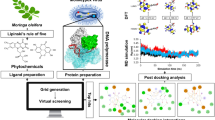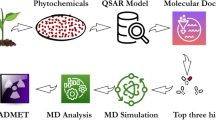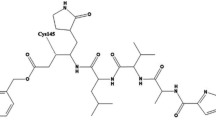Abstract
The mpox virus (MPXV), a member of the Poxviridae family, which recently appeared outside of the African continent has emerged as a global threat to public health. Given the scarcity of antiviral treatments for mpox disease, there is a pressing need to identify and develop new therapeutics. We investigated 5715 phytochemicals from 266 species available in IMMPAT database as potential inhibitors for six MPXV targets namely thymidylate kinase (A48R), DNA ligase (A50R), rifampicin resistance protein (D13L), palmytilated EEV membrane protein (F13L), viral core cysteine proteinase (I7L), and DNA polymerase (E9L) using molecular docking. The best-performing phytochemicals were also subjected to molecular dynamics (MD) simulations and in silico ADMET analysis. The top phytochemicals were forsythiaside for A48R, ruberythric acid for A50R, theasinensin F for D13L, theasinensin A for F13L, isocinchophyllamine for I7L, and terchebin for E9L. Interestingly, the binding energies of these potential phytochemical inhibitors were far lower than brincidofovir and tecovirimat, the standard drugs used against MPXV, hinting at better binding properties of the former. These findings may pave the way for developing new MPXV inhibitors based on natural product scaffolds. However, they must be further studied to establish their inhibitory efficacy and toxicity in in vitro and in vivo models.





Similar content being viewed by others
Data availability
The sequence data used in this work were obtained from NCBI. The relevant derived data are given in the supplemental tables.
References
Breman JG, Kalisa-Rutinull SMV et al (1980) Human monkeypox, 1970–79. Bull World Health Organ 58:165–182
Alakunle E, Moens U, Nchinda G, Okeke MI (2020) Monkeypox virus in Nigeria: infection biology, epidemiology, and evolution. Viruses. https://doi.org/10.3390/v12111257
Beer EM, Rao VB (2019) A systematic review of the epidemiology of human monkeypox outbreaks and implications for outbreak strategy. PLoS Negl Trop Dis 13:e0007791. https://doi.org/10.1371/journal.pntd.0007791
Mahase E (2022) Seven monkeypox cases are confirmed in England. BMJ 377:o1239. https://doi.org/10.1136/bmj.o1239
Multi-country outbreak of mpox, External situation report #23–26 May 2023. https://www.who.int/publications/m/item/multi-country-outbreak-of-mpox--external-situation-report--23---26-may-2023. Accessed 10 Jul 2023
Voigt EA, Kennedy RB, Poland GA (2016) Defending against smallpox: a focus on vaccines. Expert Rev Vaccines 15:1197–1211. https://doi.org/10.1080/14760584.2016.1175305
Bunge EM, Hoet B, Chen L et al (2022) The changing epidemiology of human monkeypox: a potential threat? A systematic review. PLoS Negl Trop Dis 16:e0010141. https://doi.org/10.1371/journal.pntd.0010141
Nguyen P-Y, Ajisegiri WS, Costantino V et al (2021) Reemergence of human monkeypox and declining population immunity in the context of urbanization, Nigeria, 2017–2020. Emerg Infect Dis 27:1007–1014. https://doi.org/10.3201/eid2704.203569
Lane HC, Montagne JL, Fauci AS (2001) Bioterrorism: A clear and present danger. Nat Med 7:1271–1273. https://doi.org/10.1038/nm1201-1271
Fact Sheet Monkeypox TPOXX treatment|FDA. https://www.fda.gov/media/160480. Accessed 10 Jul 2023
Siegrist EA, Sassine J (2023) Antivirals with activity against Mpox: A clinically oriented review. Clin Infect Dis 76:155–164. https://doi.org/10.1093/cid/ciac622
Kapoor R, Sharma D-B, Kanwar S (2017) Antiviral phytochemicals: An overview. Biochem Physiol. https://doi.org/10.4172/2168-9652.1000220
WHO traditional medicine strategy: 2014–2023. https://www.who.int/publications-detail-redirect/9789241506096. Accessed 10 Jul 2023
Izzedine H, Launay-Vacher V, Deray G (2005) Antiviral drug-induced nephrotoxicity. Am J Kidney Dis 45:804–817. https://doi.org/10.1053/j.ajkd.2005.02.010
Vaou N, Stavropoulou E, Voidarou C et al (2021) Towards advances in medicinal plant antimicrobial activity: a review study on challenges and future perspectives. Microorganisms 9:2041. https://doi.org/10.3390/microorganisms9102041
Ghate SD, Suravajhala P, Patil P et al (2023) Molecular detection of monkeypox and related viruses: challenges and opportunities. Virus Genes 59:343–350. https://doi.org/10.1007/s11262-023-01975-3
Lam HYI, Guan JS, Mu Y (2022) In silico repurposed drugs against monkeypox virus. Molecules 27:5277. https://doi.org/10.3390/molecules27165277
Berman HM, Westbrook J, Feng Z et al (2000) The protein data bank. Nucleic Acids Res 28:235–242. https://doi.org/10.1093/nar/28.1.235
Mirdita M, Schütze K, Moriwaki Y et al (2022) ColabFold: making protein folding accessible to all. Nat Methods 19:679–682. https://doi.org/10.1038/s41592-022-01488-1
Shetty S, Shastry PR, Shetty V et al (2022) Functional analysis of Escherichia coli K12 toxin-antitoxin systems as novel drug targets using a network biology approach. Microb Pathog. https://doi.org/10.1016/j.micpath.2022.105683
Trott O, Olson AJ (2010) AutoDock Vina: improving the speed and accuracy of docking with a new scoring function, efficient optimization and multithreading. J Comput Chem 31:455–461. https://doi.org/10.1002/jcc.21334
Mohanraj K, Karthikeyan BS, Vivek-Ananth RP et al (2018) IMPPAT: a curated database of Indian medicinal plants. Phytochem Ther Sci Rep 8:4329. https://doi.org/10.1038/s41598-018-22631-z
Friesner RA, Murphy RB, Repasky MP et al (2006) Extra precision glide: docking and scoring incorporating a model of hydrophobic enclosure for protein−ligand complexes. J Med Chem 49:6177–6196. https://doi.org/10.1021/jm051256o
Tareq Hassan Khan M (2010) Predictions of the ADMET properties of candidate drug molecules utilizing different QSAR/QSPR modelling approaches. CDM 11:285–295. https://doi.org/10.2174/138920010791514306
Hansson T, Oostenbrink C, van Gunsteren W (2002) Molecular dynamics simulations. Curr Opin Struct Biol 12:190–196. https://doi.org/10.1016/S0959-440X(02)00308-1
Malkaje S, Srinivasa MG et al (2023) An In-silico approach: design, homology modeling, molecular docking, MM/GBSA simulations, and ADMET screening of novel 1,3,4-oxadiazoles as PLK1inhibitors. Curr Drug Res Rev 15:88–100
Prajapati J, Patel R, Goswami D et al (2021) Sterenin M as a potential inhibitor of SARS-CoV-2 main protease identified from MeFSAT database using molecular docking, molecular dynamics simulation and binding free energy calculation. Comput Biol Med 135:104568. https://doi.org/10.1016/j.compbiomed.2021.104568
Genheden S, Ryde U (2015) The MM/PBSA and MM/GBSA methods to estimate ligand-binding affinities. Expert Opin Drug Discov 10:449–461. https://doi.org/10.1517/17460441.2015.1032936
Amadei A, Linssen ABM, Berendsen HJC (1993) Essential dynamics of proteins. Proteins Struct Funct Bioinform 17:412–425. https://doi.org/10.1002/prot.340170408
Van Der Spoel D, Lindahl E, Hess B et al (2005) GROMACS: Fast, flexible, and free. J Comput Chem 26:1701–1718. https://doi.org/10.1002/jcc.20291
Bowers KJ, Chow DE, Xu H, et al (2006) Scalable algorithms for molecular dynamics simulations on commodity clusters. In: SC ’06: proceedings of the 2006 ACM/IEEE conference on supercomputing, p 43
Hughes SJ, Johnston LH, de Carlos A, Smith GL (1991) Vaccinia virus encodes an active thymidylate kinase that complements a cdc8 mutant of Saccharomyces cerevisiae. J Biol Chem 266:20103–20109. https://doi.org/10.1016/S0021-9258(18)54896-1
Colinas RJ, Goebel SJ, Davis SW et al (1990) A DNA ligase gene in the Copenhagen strain of vaccinia virus is nonessential for viral replication and recombination. Virology 179:267–275. https://doi.org/10.1016/0042-6822(90)90295-3
Wang YC, Burkhart WA, Mackey ZB et al (1994) Mammalian DNA ligase II is highly homologous with vaccinia DNA ligase. Identification of the DNA ligase II active site for enzyme-adenylate formation. J Biol Chem 269:31923–31928. https://doi.org/10.1016/S0021-9258(18)31783-6
Zhang Y, Moss B (1992) Immature viral envelope formation is interrupted at the same stage by lac operator-mediated repression of the vaccinia virus D13L gene and by the drug rifampicin. Virology 187:643–653. https://doi.org/10.1016/0042-6822(92)90467-4
Blasco R, Moss B (1991) Extracellular vaccinia virus formation and cell-to-cell virus transmission are prevented by deletion of the gene encoding the 37,000-Dalton outer envelope protein. J Virol 65:5910–5920. https://doi.org/10.1128/jvi.65.11.5910-5920.1991
Hirt P, Hiller G, Wittek R (1986) Localization and fine structure of a vaccinia virus gene encoding an envelope antigen. J Virol 58:757–764. https://doi.org/10.1128/jvi.58.3.757-764.1986
Roper RL, Moss B (1999) Envelope formation is blocked by mutation of a sequence related to the HKD phospholipid metabolism motif in the vaccinia virus F13L protein. J Virol 73:1108–1117. https://doi.org/10.1128/jvi.73.2.1108-1117.1999
Byrd CM, Hruby DE (2005) Development of an in vitro cleavage assay system to examine vaccinia virus I7L cysteine proteinase activity. Virol J 2:63. https://doi.org/10.1186/1743-422X-2-63
Byrd CM, Bolken TC, Hruby DE (2002) The vaccinia virus I7L gene product is the core protein proteinase. J Virol 76:8973–8976. https://doi.org/10.1128/jvi.76.17.8973-8976.2002
Katritch V, Byrd CM, Tseitin V et al (2007) Discovery of small molecule inhibitors of ubiquitin-like poxvirus proteinase I7L using homology modeling and covalent docking approaches. J Comput Aided Mol Des 21:549–558. https://doi.org/10.1007/s10822-007-9138-7
Andrei G, Fiten P, Krečmerová M et al (2022) Poxviruses bearing DNA polymerase mutations show complex patterns of cross-resistance. Biomedicines 10:580. https://doi.org/10.3390/biomedicines10030580
Vaidya ADB, Devasagayam TPA (2007) Current status of herbal drugs in India: an overview. J Clin Biochem Nutr 41:1–11. https://doi.org/10.3164/jcbn.2007001
Gong L, Wang C, Zhou H et al (2021) A review of pharmacological and pharmacokinetic properties of Forsythiaside A. Pharmacol Res 169:105690. https://doi.org/10.1016/j.phrs.2021.105690
Zheng X, Fu Y, Shi S-S et al (2019) Effect of forsythiaside A on the RLRs signaling pathway in the lungs of mice infected with the influenza A virus FM1 strain. Molecules 24:4219. https://doi.org/10.3390/molecules24234219
Law AH-Y, Yang CL-H, Lau AS-Y, Chan GC-F (2017) Antiviral effect of forsythoside A from Forsythia suspensa (Thunb.) Vahl fruit against influenza A virus through reduction of viral M1 protein. J Ethnopharmacol 209:236–247. https://doi.org/10.1016/j.jep.2017.07.015
Chen X, Wu Y, Chen C et al (2021) Identifying potential anti-COVID-19 pharmacological components of traditional Chinese medicine Lianhuaqingwen capsule based on human exposure and ACE2 biochromatography screening. Acta Pharm Sin B 11:222–236. https://doi.org/10.1016/j.apsb.2020.10.002
Prajapati SN, Parmar KA (2011) Anti-viral and in-vitro free radical scavenging activity of leaves of Rubia cordifolia. Int J Phytomed 3:98–107
Isaacs CE, Xu W, Merz G et al (2011) Digallate dimers of (−)-epigallocatechin gallate inactivate herpes simplex virus. Antimicrob Agents Chemother 55:5646–5653. https://doi.org/10.1128/aac.05531-11
Sahoo AK, Augusthian PD, Muralitharan I et al (2022) In silico identification of potential inhibitors of vital monkeypox virus proteins from FDA approved drugs. Mol Divers. https://doi.org/10.1007/s11030-022-10550-1
Patel M, Bazaid AS, Azhar EI et al (2023) Novel phytochemical inhibitors targeting monkeypox virus thymidine and serine/threonine kinase: integrating computational modeling and molecular dynamics simulation. J Biomol Struct Dyn. https://doi.org/10.1080/07391102.2023.2179547
Gulati P, Chadha J, Harjai K, Singh S (2022) Targeting envelope proteins of poxviruses to repurpose phytochemicals against monkeypox: an in silico investigation. Front Microbiol 13:1073419
Acknowledgements
This work did not receive any specific funding.
Author information
Authors and Affiliations
Contributions
SDG and RSPR planned the work. LP, SA, and SDG performed the work and along with RSPR wrote the manuscript. MGS helped in data curation. RBC helped in interpreting the results and gave critical inputs. RKV and PN gave inputs on phytochemicals and drug discovery. All authors contributed intellectually and edited/reviewed the manuscript. All authors have read and agreed to the published version of the manuscript.
Corresponding authors
Ethics declarations
Conflict of interest
The authors declare that they have no conflict of interest.
Ethical approval
The work is in compliance with ethical standards. No ethical clearance was necessary.
Additional information
Publisher's Note
Springer Nature remains neutral with regard to jurisdictional claims in published maps and institutional affiliations.
Supplementary Information
Below is the link to the electronic supplementary material.
Rights and permissions
Springer Nature or its licensor (e.g. a society or other partner) holds exclusive rights to this article under a publishing agreement with the author(s) or other rightsholder(s); author self-archiving of the accepted manuscript version of this article is solely governed by the terms of such publishing agreement and applicable law.
About this article
Cite this article
Ghate, S.D., Pinto, L., Alva, S. et al. In silico identification of potential phytochemical inhibitors for mpox virus: molecular docking, MD simulation, and ADMET studies. Mol Divers (2024). https://doi.org/10.1007/s11030-023-10797-2
Received:
Accepted:
Published:
DOI: https://doi.org/10.1007/s11030-023-10797-2




